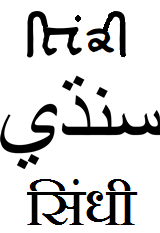Language/Sindhi/Grammar/How-to-Use-Be
Hi Sindhi learners! 😊
In this lesson, you will learn how to use "be" in Sindhi grammar. "Be" is one of the most important verbs in any language because it helps to indicate the existence of someone or something. In addition, it is used to describe qualities, identities, and states of being.
After mastering this lesson, these related pages might interest you: Questions & Future Tense.
Present Tense[edit | edit source]
In Sindhi, the verb "be" is translated as جيو (jeeyo). It follows the same conjugation rules as other verbs in present tense. Let's see a few examples below:
| Sindhi | Pronunciation | English |
|---|---|---|
| مجهي جيو آهين. | Majhi jeeyo aahin. | I am here. |
| تون جيو آهيس. | Tun jeeyo aahis. | You are here. |
| انهنجو جيو آهيو. | Anhijunjo jeeyo aahyo. | They/Them are here. |
Negative Form of Present Tense[edit | edit source]
To make a negative sentence, you can add the word نه (nah) after the verb. Here are a few examples:
| Sindhi | Pronunciation | English |
|---|---|---|
| مجهي جيو نه آهين. | Majhi jeeyo nah aahin. | I am not here. |
| تون جيو نه آهيس. | Tun jeeyo nah aahis. | You are not here. |
| انهنجو جيو نه آهيو. | Anhijunjo jeeyo nah aahyo. | They/Them are not here. |
Interrogative Form of Present Tense[edit | edit source]
To ask a question in present tense, you can simply switch the subject and the verb. Here are a couple of examples:
| Sindhi | Pronunciation | English |
|---|---|---|
| جي مجهي آهين جو? | Ji majhi aahin jo? | Am I here? |
| تون جيو آهيس جي؟ | Tun jeeyo aahis ji? | Are you here? |
| جي انهنجو آهيو جي؟ | Ji anhijunjo aahyo ji? | Are they/them here? |
Past Tense[edit | edit source]
In Sindhi, the past tense of "be" is translated as تيون (tayo). Let's see a few examples below:
| Sindhi | Pronunciation | English |
|---|---|---|
| مجهي تيون ته آهيو. | Majhi tayo teh aahyo. | I was there. |
| تون تيون ته آهيو. | Tun tayo teh aahyo. | You were there. |
| انهنجي تيون ته آهين. | Anhiji tayo teh aahin. | They/Them were there. |
Negative Form of Past Tense[edit | edit source]
To make a negative sentence in past tense, you can add the word نه (nah) after the verb. Here are a few examples:
| Sindhi | Pronunciation | English |
|---|---|---|
| مجهي تيون ته نه آهيو. | Majhi tayo teh nah aahyo. | I was not there. |
| تون تيون ته نه آهيو. | Tun tayo teh nah aahyo. | You were not there. |
| انهنجي تيون ته نه آهين. | Anhiji tayo teh nah aahin. | They/Them were not there. |
Interrogative Form of Past Tense[edit | edit source]
To ask a question in past tense, you can switch the order of the subject and the verb. Here are a few examples:
| Sindhi | Pronunciation | English |
|---|---|---|
| ته مجهي تيون آهيو؟ | Teh majhi tayo aahyo? | Was I there? |
| ته تون تيون آهيو؟ | Teh tun tayo aahyo? | Were you there? |
| ته انهنجي تيون آهين؟ | Teh anhiji tayo aahin? | Were they/Them there? |
Dialogue[edit | edit source]
Here's a dialogue between two Sindhi speakers who use the verb "be" in the exchange:
- Person 1: تون جيو آهيس، جي؟ (Tun jeeyo aahis ji?)
(Are you here?) - Person 2: ۾ڙه پڇو آهيو. (Merhe pichho aahyo.)
(I am behind you.)
- Person 1: جي مجهي تيون آهيو. (Ji majhi tayo aahyo.)
(Am I there?) - Person 2: نه، تو هن صحن جيئينداس. (Nah tun hin sahan jeeyendas.)
(No, you are in the other room.)
Conclusion[edit | edit source]
In this lesson, you've learned how to use the verb "be" in present and past tenses in Sindhi grammar. Keep practicing by using the examples in your daily life and talking to native speakers. Sindhi is a beautiful language to learn, and knowing its basic grammar concepts will help you to better communicate with Sindhi speakers. If you want to learn more about Sindhi grammar or other aspects of the language, check out the Sindhi grammar section on the Polyglot Club website. 😊
➡ If you have any questions, please ask them in the comments section below.
➡ Feel free to edit this wiki page if you think it can be improved. 😎
Having concluded this lesson, consider checking out these related pages: How to Use Have & Adjectives.
Other Lessons[edit | edit source]
- Questions
- Conditional Mood
- Negation
- How to Use Have
- Plurals
- Adjectives
- Future Tense
- Pronouns
- Give your Opinion
Sources[edit | edit source]

